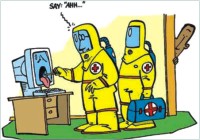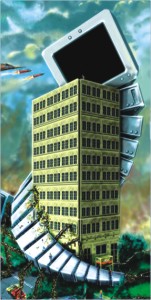| Spotlight
Keep cyber annoyances at bay
Edward Apurba Singha
 Soaring popularity of the internet has dramatically changed our lifestyle and gradually increased our dependency on it. Today internet is a virtual world where we get almost everything essential to our daily life activities. Soaring popularity of the internet has dramatically changed our lifestyle and gradually increased our dependency on it. Today internet is a virtual world where we get almost everything essential to our daily life activities.
But internet is not a safe harbour of resources and surprisingly we usually pay little attention on security issues when we browse the web.
For instance, in many cases we are reluctant to update our anti-virus software regularly as well as not aware of spam and spyware. In this article I tried to disclose some essential information regarding virus, spam and spyware in order to create awareness so that you will take adequate measure to protect yourself from cyber annoyances.
Electronic Infection
The term 'electronic infection' apparently refers to the viruses or other malicious programs that are spread over the internet or LAN (Local Area Network) and by portable devices such as flash memory, floppy disk etc.
Virus in general is an executable computer code that is designed to reproduce itself in the infected devices. Viruses are created in order to attack particular organisation or disrupt the function of specific computer program.
 Virus is a generic name and it can be subdivided as follows: Virus is a generic name and it can be subdivided as follows:
Boot sector virus
A boot sector virus affects the boot sector of your hard disk and floppy disk. A tiny program resides in the boot sector that helps to load the operating system. By putting its code in the boot sector, a virus can guarantee it's execution. It can load itself into memory immediately, and it is able to run whenever the computer is on.
Introduction of compact disc (CD) obstructed wide spread infection of boot sector virus. Nowadays almost all software distribute on a compact disc. Data on compact discs cannot be modified, and that makes viral infection of a CD almost impossible.
The age of boot sector viruses is on the verge of extinction because modern operating systems have mechanism to protect the boot sector. Examples of boot viruses are Polyboot.B and AntiEXE.
 Multipartite virus Multipartite virus
A virus that is capable of attacking both the boot sector and the executable, or programmes and files at the same time. When the virus attaches to the boot sector, it will in turn affect the system files, and when the virus attaches to the files, it will in turn infect the boot sector. This type of virus can continue its replication if all parts of the virus is not eradicated.
Macro virus
Files that are created using certain applications or programs that contain macros are vernuable to macro viruses. These include Microsoft Office documents such as Word documents, Excel spreadsheets, PowerPoint presentations, Access databases and other similar application files such as Corel Draw, AmiPro etc. Macro viruses tend to be surprising but relatively harmless. A macro virus is often spread as an email virus. The first macro virus was written for Microsoft Word and was discovered back in August 1995. Today, there are thousands of macro viruses in existencesome examples are Relax, Melissa.A and Bablas. pc.
Stealth virus
In computer security, a stealth virus is a computer virus that uses various mechanisms to avoid detection by antivirus software. Typically, when an antivirus program runs, a stealth virus hides itself in memory, and uses various tricks to also hide changes it has made to any files or boot records.
The virus may maintain a copy of the original, uninfected data and monitor system activity. When the program attempts to access data that's been altered, the virus redirects it to a storage area maintaining the original, uninfected data. A good antivirus program should be able to find a stealth virus by looking for evidence in memory as well as in areas that viruses usually attack.
 Email virus Email virus
As the name implies email viruses spread by the email message. As soon as this virus infected a computer it autometically searches address book and send its copy to the people listed in the address book.
Logic bomb
A bomb is a program that camouflages its existence and outbursts by a particular condition, such as a date.
Two other types of malware that intimidate the cyber world are Trojan horse and Worm often classified as virus.
Trojan horse: A Trojan horse is a malicious program that passes itself off as a benign application; it cannot reproduce itself and, like a virus, are distributed by diskette or electronic mail.
Worm: A worm is a destructive program that propagates itself over a network, reproducing as it goes. Mydoom and ILoveYou are two examples of worms.
Spam
Suppose you are planning to launch a business. So first of all you require a good campaign to promote your products. Due to moderate investment you avoid expensive advertisement and deliberately choose the internet to promote your products. You select hundred email IDs of your friends and well-wishers. Then you send information to them regarding your products. If few of them respond to your request you will earn some money. This is a smart way without any expense. Many people and business organisations follow this scheme to expand their business. As a result, you often encounter some unsolicited email in your inbox. Microsoft, which operates internet service provider MSN plus e-mail service Hotmail, says it blocks an average of 2.4 billion spams per day.
Spammers collect your email ID from websites as well as some professional organisations that collect email IDs and sell them on compact disc (CD). There are tens of millions of websites, and spammers can create search engines that spider the web specifically looking for the telltale "@" sign that indicates an e-mail address. The programs that do the spidering are often called spambots.
The technology that is employed nowadays to stop spam is spam-filtering software. More advanced filters, known as Heuristic filters and Bayesian filters; statistically identify spam based on word patterns or word frequency. But there are still ways to get around them (mainly by using short messages).
 Large ISPs tried blocking multiple e-mails with the same subject line or message body. This had the unwanted side-effect of blocking e-mail newsletters, so ISPs made "white lists" to identify legitimate newsletter senders. Then spammers sidestepped the issue by inserting different random characters into each subject line and message body. That's why you get e-mail messages with subject lines. Large ISPs tried blocking multiple e-mails with the same subject line or message body. This had the unwanted side-effect of blocking e-mail newsletters, so ISPs made "white lists" to identify legitimate newsletter senders. Then spammers sidestepped the issue by inserting different random characters into each subject line and message body. That's why you get e-mail messages with subject lines.
Spyware
Spywares are computer programmes that attach itself to the operating system in nefarious way. Some people contradict spyware with virus. But they behave differently. A virus accomplishes destructive activities whereas a spyware just collect information without notifying people.
In a spyware infected machine users frequently notice unwanted behavior and degradation of system performance. A spyware infestation can create significant unwanted CPU activity, disk usage, and network traffic, all of which slow the computer down. Stability issues, such as application or system-wide crashes, are also common. Spyware, which interferes with networking software commonly, causes difficulty connecting to the internet.
The best way to eliminate spyware is to use spyware scanner and pop-up blocker. In addition take some precautions such as disable Active X, avoid unknown software installation and use "X" to close pop-up windows.
References: wikipedia.org, howstuffworks.com
First published on Sat. March 10, 2007 in StarTech
Copyright
(R) thedailystar.net 2008
|

